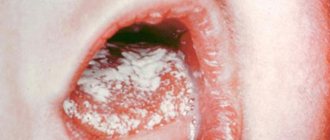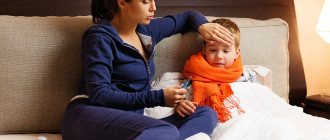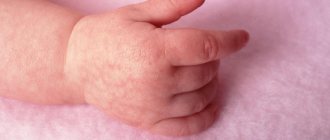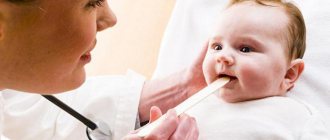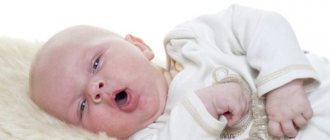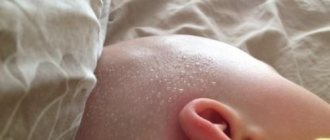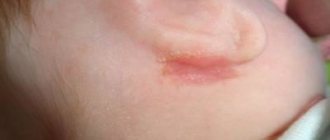0
21559
Every parent wants their child to be healthy and happy. However, in the modern world there is always a risk of getting some kind of disease. At the same time, many diseases have symptoms that do not seem to interfere with normal life for the time being. Therefore, every unusual symptom makes vigilant mothers and fathers wary. After all, many diseases, if left untreated, can cause serious harm to a child’s body. One of these suspicious manifestations is sweaty palms in a baby or teenager. Of course, this problem can arise under the influence of external factors, but malfunctions in the body cannot be ruled out. Why such a pathology can occur and how to deal with it - read on.
Is sweating normal?
Sweating is a completely normal process for a healthy person. After all, it is due to the separation of this secretion through the pores on the skin that the body’s thermoregulation occurs. In addition, this process is involved in the removal of toxins and acid-salt metabolism, and sweat also performs a barrier function, preventing the penetration of microorganisms through the skin.
The first few months after birth, the thermoregulation of the child’s body is not fully formed. Therefore, even when sweating in hot weather, in a baby up to one month old, a temperature rise of up to 37 degrees is considered normal.
Sweating is normal for both babies and toddlers. Of course, if it occurs within reasonable limits. It is worth noting that sweating in adolescents during puberty and in children is different. This happens because during these periods different glands are responsible for all processes.
Glands responsible for sweating:
- Eccrine glands are located throughout the body. They are present in large numbers, but they are especially numerous on the palms, feet, armpits, neck, face and head. These elements are responsible for thermoregulation of the body, as well as for the removal of toxins, acid-base balance and protection against bacteria. They work for both children and adults.
- Apocrine glands are present only in certain areas of the body. Their functions are still not fully understood. It is only known that they secrete pheromones that determine the natural aroma of the body. These components of the system are present from birth, but begin to work only during puberty.
This is why teenagers sweat much more than young children. However, normally this manifestation should not be critical.
When to sound the alarm
If your child’s palms are a little sweaty, then it’s too early to worry. Due to the accumulation of a large number of eccrine glands in these areas, this situation is considered normal. However, if parents notice that the baby’s palms are damp and even wet almost always, then it is very important to visit a doctor on time.
There are several signs indicating that a child’s hands are sweating due to negative factors or pathological processes. They will help you understand when to worry. Symptoms that cause alarm:
- Excessive sweating when the child is at rest. For example, when he eats, sleeps or watches cartoons;
- Fever or loss of strength. Loss of energy is a temperature below 36 degrees;
- Presence of cold sweat. The child may complain that he is cold;
- Moodiness, tearfulness, overexcitation or lethargy are also alarming symptoms;
- Sweating is accompanied by an unpleasant odor. This sign is normally not typical for children;
- The occurrence of skin irritations, for example, heat rashes;
- Sweating in one area of the body. For example, if only the baby’s hands sweat.
These symptoms do not indicate illness, but indicate that the child is being affected by some negative factor. In this case, the reason can be both external and internal. It is normal for a child to sweat during active play. Excessive mobility in most cases is accompanied by the release of sweat from the eccrine glands.
Provoking factors
There are several factors that cause excessive sweating in infants. It is worth considering that these factors are normal and do not pose any danger to the health of the baby.
- Items of clothing. Many parents strive to dress their child well not only in winter, but also in the warm seasons of the year. Such measures worsen the development of thermoregulation, which contributes to the baby overheating and then freezing.
- Ambient temperature indicator. The child's palms and feet sweat if he is in a dry and too warm space, as well as during physical exertion. To prevent this, it is necessary to check the microclimate in the room where the baby is growing several times a day.
- Stressful situations. Sweating of the feet and palms of an infant can be caused by internal irritants. This is due to the fact that during nervous overexcitation, the sweat glands receive a signal coming from the nerve endings. This impulse provokes an increase in the amount of sweat produced. In this situation, parents need to carefully monitor the nervous state of their baby, and if irritability is present, eliminate the cause of its appearance.
- Nutrition. If a baby overeats, his mood becomes excitable, he begins to worry, be capricious, and sweat. In order to cope with the emerging problem, parents should adjust their baby’s diet, and the problem will disappear in a few days.
- Too much fatigue, lack of sleep. Failures in the daily routine can cause increased sweating in the child’s legs and arms. To eliminate hyperhidrosis, it is necessary to adjust your daily routine and adhere to its routine.
Factors that cause increased sweating in the extremities in infants are normal. In most cases, after eliminating them, the problem itself disappears. This is due to the fact that in infancy, the body’s heat transfer abilities are not fully formed, and the body can overheat if not properly cared for.
Parents can suspect pathology only if the child has wet palms and his age has reached 1.5 years. In this case, the child’s palms and feet sweat due to certain pathologies.
Causes not related to diseases
Often the cause of the problem lies in superficial factors. This condition is not dangerous, but it requires adjustment to improve the child’s well-being. It is enough just to remove the negative factor, and the problem will go away.
External factors contributing to the problem:
- Excessively high ambient temperature. Sweaty palms are often observed on hot summer days and during the heating season, if the apartment warms up too much;
- When wearing clothes that do not allow enough air to pass through, this condition can also develop. This pathology occurs especially often in those who prefer synthetic clothing;
- Excess water in the body can also result in increased sweating. At the same time, the baby needs to drink very little for this factor to occur;
- Increased activity also provokes increased work of the sweat glands. However, this factor is not only harmless, but also useful;
- Lack of physical activity can also be a reason that causes sweaty palms. However, in this case, everything happens the other way around. That is, the body becomes unaccustomed to stress, and at the slightest activity it begins to sweat heavily;
- Nervous stress can also cause a similar situation. Crying, overexcitement and other similar factors cause the child to sweat;
- The use of drugs with similar side effects can also cause hyperhidrosis.
In such situations, increased sweating occurs for completely natural reasons. It is enough just to eliminate the negative factor, and the baby’s palms will stop sweating.
Causes of foot hyperhidrosis
If only the baby’s feet sweat a lot, parents should pay attention to the following factors that provoke this pathology:
- incorrectly selected shoes;
- synthetic shoes or socks;
- poor foot hygiene;
- presence of fungus.
To eliminate excessive sweating, parents should eliminate the factor that provokes its development as soon as possible, otherwise advanced hyperhidrosis can cause dangerous complications.
Pathological causes
Some parents wonder: why does the child have wet palms or feet, but does he have a good appetite, sleep, and mood? In this case, the symptom of excessive sweating may indicate a pathology developing in his body.
- In some cases, sweaty palms and feet occur due to a hereditary predisposition to hyperhidrosis. This phenomenon is provoked by the structure of the sweat glands and their activity.
- Why do my child’s palms sweat and his appetite worsen? In this case, the baby should be shown to a doctor and tested for parasites. Such symptoms occur against the background of the fact that the body is trying to eliminate toxins formed during parasitic activity by secreting large amounts of sweat. In this case, not only the limbs, but also most of the body will sweat.
- Pathologies of the thyroid gland, as well as disorders of its functions, can be the root cause of why a baby has wet extremities.
- An infant may suffer from vegetative-vascular dystonia, which is characterized by vascular spasms and malfunctions of the systems necessary for life. One of such systems is thermoregulation.
- Failures in water-salt balance are characterized not only by sweating of the extremities, but also by their swelling.
- Vitamin D deficiency, which causes rickets, can cause excessive sweating of the extremities. Therefore, when such symptoms appear, the child needs to donate blood to diagnose the level of calcium in the blood. The attending physician should also assess the tone of the abdominal wall muscles. Rickets can also be suspected based on other symptoms, for example, the appearance of bald patches, curvature of the bones of the lower extremities, loss of appetite, and enlargement of the abdominal area.
- Lymphatic diathesis pathology may explain why extremities sweat. This disease is not considered particularly dangerous for a child, but it requires therapy.
In order to understand why the baby has sweaty limbs, parents should carefully monitor the well-being of their child. If alarming symptoms appear, the baby should be shown to a pediatrician as soon as possible to diagnose a possible pathology and its further treatment.
Diseases that cause excessive sweating
A sign such as wet palms is not always harmless. This condition may be a symptom of a serious illness. Therefore, if the problem does not disappear after eliminating negative factors, then it is likely that its cause lies in the disease.
Why do baby's palms sweat?
- One possible reason could be parasite infection. For example, such a symptom can be caused by helminthic infestation;
- Obesity is another common cause of excessive sweating. If a child constantly sweats and is overweight, then there is a high probability that it is all a matter of overeating;
- There is also a congenital form of hyperhidrosis. This condition has not yet been fully studied. However, it is known that it can be inherited;
- Hyperthermia is a disease in which the body cannot cope with its thermoregulatory function. It is also inherited and causes excessive sweating;
- During puberty, this problem often arises due to pressure surges. This condition occurs especially often with hypertension;
- Heart diseases, such as heart defects, are also expressed as a symptom in the form of sweating. It happens that the baby has a congenital heart defect;
- Diseases of the endocrine system are also often manifested by sweating palms. Recently, quite a large number of children suffer from diabetes;
- During puberty, hormonal imbalances often occur. Therefore, many teenagers complain of excessive sweating;
- Increased sweating can cause viral and infectious diseases. Thus, profuse sweat during sleep is characteristic of patients with tuberculosis;
- Diseases of the nervous system are also often expressed by this symptom;
- In case of any diseases accompanied by elevated body temperature, increased sweating will be observed;
- Symptoms of hyperhidrosis are characteristic of food and toxic poisoning. This is one of the signs of intoxication of the body.
Many of the problems described are quite dangerous. Therefore, if excessive sweating occurs, especially when accompanied by other symptoms, you should immediately consult a doctor.
Therapy
Treatment of increased sweating caused by various pathologies is prescribed only by the attending physician based on the individual data of the infant, as well as the stage of development of the pathology affecting his body. If your hands and feet sweat for natural reasons, parents need to follow a few simple rules:
- Maintain hygiene standards when caring for yourself and your baby. Sweaty limbs should be washed using baby soap. When bathing in the bath, you need to add sea salt, a weak infusion of sage, mint or oak bark. Before going to bed, problem areas should be treated with drying powder.
- If your baby's palms and feet sweat, he should change his underwear and bedding daily. All newborn clothing should be made from high-quality natural materials.
- The temperature in the room where the baby is located should not be higher than 20 degrees, and the humidity should not exceed 60%.
- An older baby needs to be toughened up. Children should take frequent walks in the sun and engage in active play. Babies sleeping outside should be covered with an extra blanket, but parents should check frequently to make sure their baby is not overheating.
- If your baby's feet are constantly wet, you can massage them. During bathing, the soles should be subjected to various pats, stroking, and pinching.
- To relieve nervous tension, gentle tactile contact should be established more often with the baby. It is in this state that the child feels the safety and love of his parents, which helps normalize his emotional background and reduce sweating.
- A baby's wet palms and feet may be a result of hyperactivity. In this situation, pediatricians prescribe various herbal preparations for the child.
Causes of sweating in newborns
If a newborn's palms sweat, this does not mean that the baby is seriously ill. However, this sign needs to be given enough attention. Of course, it is quite possible that hyperhidrosis occurs after one of the factors described above. However, there are several most common reasons why a baby's palms sweat.
Why do baby's palms sweat?
- This problem often occurs in premature babies. These babies are usually born with a dysfunctional thermoregulation system.
- This problem may also arise due to the fact that the child is fed artificial formula. In this case, this factor contributes to overeating and the fact that the newborn does not receive the necessary immune cells. This leads to hyperhidrosis.
- Sweating is also often a sign of rickets. However, most children suffer from this manifestation. Therefore, babies are often prescribed vitamin D3 in the first months of life.
Causes
When parents notice that their child’s hands are sweating, they should not think that the baby is sick and has a fever. The reasons why palms become wet are provocateurs from the following series:
- The process of thermoregulation is not established (applies exclusively to children under 1.5 years old);
- the presence of rickets (the disease is provoked by a lack of vitamin D, which disrupts phosphorus-calcium metabolism);
- disruption of the normal functioning of the thyroid gland;
- the temperature in the house is too high or the toddler is dressed tightly;
- the boy or girl is overfed;
- there is iodine deficiency in the baby’s body;
- the presence of vegetative-vascular dystonia, which provokes increased sweating;
- failure to comply with personal hygiene rules;
- manifestation of a hereditary factor (if parents suffer from this problem, then there is a possibility that it will be passed on to the heir);
- the presence of helminths in the body.
To get reliable information about why a child’s palms are sweating, parents should take their child to the doctor.
In newborns
Toddlers who are 2-3 months old or even older experience sweaty hands because their body has not established the process of thermoregulation. This is considered normal, but in boys and girls who are over one and a half years old, this process should stop.
The cause of hyperhidrosis in newborns lies in the following factors:
- jumps in the baby's growth process;
- individual characteristics of thermoregulation in a particular organism;
- the nervous system does not fully cope with its functions;
- manifestation of heredity;
- Parents do not pay enough attention to the hygiene of the newborn.
Baby's heat rash
Children often suffer from heat rash. This is especially true for children born in the hot months of the year. This happens because the secretion of the sweat glands does not have time to evaporate and irritates the baby’s delicate skin.
Miliaria can be crystalline and is what usually occurs in children. This type of rash is not dangerous and has no symptoms other than papular pimples. If the miliaria causes itching and anxiety in the child, then this phenomenon is inflammatory in nature and requires immediate consultation with a specialist. This problem often occurs when an infection is attached.
A little about sweating during puberty
During puberty, excessive sweating is quite natural. At this time, the second type of glands begins to work, and hormonal disruptions occur in the body. In turn, this leads to nervous stress.
Due to these three factors, increased sweating is observed. It is not dangerous and does not require adjustment. However, it is still worth getting examined if you have hyperhidrosis in order to exclude more serious causes of this condition.
Primary and secondary hyperhidrosis
It is worth noting that hyperhidrosis is divided into two types. It can be primary and secondary. Types of hyperhidrosis:
- Primary hyperhidrosis is present at birth. The causes of this disease have not been studied. It is believed that it is inherited;
- The secondary type of pathology is diagnosed when it is not an independent disease, but only a sign of some disease.
Secondary hyperhidrosis is the most dangerous, as it can be a symptom of a serious illness.
Diagnostic methods
Hyperhidrosis of the palms requires careful diagnosis. If such a problem occurs in children, you should first of all contact a pediatrician. The pediatrician will study the medical history and also examine the little patient.
Next, a test is performed to determine the degree of pathology. To do this, apply an iodine solution to the palms, and after it dries, starch. When your palms begin to sweat, the starch turns blue when it reacts with iodine. The stage of hyperhidrosis is determined by the scale of the painted surface. After this, an examination is scheduled.
Usually the patient is prescribed a general and biochemical analysis of blood and urine to identify inflammatory and other negative components in their composition. Also, depending on the suspected cause, one or another hardware test is prescribed.
Treatment of the problem
Treatment for hyperhidrosis is chosen depending on the factors that caused it. Sometimes treatment is not required, you just need to exclude an external cause. If there is a disease that causes a symptom in the form of sweating, the doctor will prescribe treatment. Usually this is a course of medications. However, sometimes physiotherapy and surgical interventions are indicated.
Rarely used techniques
There are techniques that are quite actively used to treat adults, but are rarely used for children. These include injecting Botox into the problem area, pinching the nerves that communicate with the sweat glands, and injecting weakened botulism bacteria. Such treatment methods are used extremely rarely in the case of childhood hyperhidrosis. They can be prescribed in adolescence in exceptional cases.
It is also worth noting such therapy as iontophoresis. This method is safer than those given above, but is also undesirable for children. In this case, micropulses of current are passed through the palms, blocking the sweat glands.
Folk recipes
Folk remedies for hyperhidrosis can also be used. However, their use is possible only after consultation with a specialist. After all, children are especially sensitive to such drugs. To eliminate the possibility of prickly heat in a child during the hot season, he is bathed in a bath with a decoction of soothing and skin-healing herbs. For example, herbs are often used with a decoction of string or walnut leaves.
During puberty, the child can be given decoctions of soothing herbs to drink. It is likely that such products will help reduce sweating. Among the most popular remedies are valerian tincture and lemon balm tea.
What is palmar hyperhidrosis?
Hyperhidrosis of the palms manifests itself with very characteristic signs:
- when touching paper, fabric and other materials, a wet palm mark remains on them;
- the skin of the palms periodically turns red;
- The palms are constantly wet, or beads of sweat often appear on them.
Degrees of severity of hand hyperhidrosis
There are several stages of this pathology depending on the severity of the manifestations:
- Light flow. Palms are constantly wet.
- Moderate. Not only your palms are wet, but also your fingers.
- Severe form. Sweat flows down the palms profusely.
Why do my palms sweat a lot?
The most common form of hyperhidrosis is idiopathic. It develops without cause from infancy and intensifies during adolescence. This form is not harmful to health, but can cause serious discomfort.
In addition, there are many reasons that lead to increased sweating of the palms:
- excessive activity of the sympathetic nervous system (it is responsible for sweating);
- vegetative-vascular dystonia;
- disruption of the hormonal system or the period of “restructuring the body” (adolescence, pregnancy, menopause);
- genetic predisposition;
- psychological problems (for example, frequent stress).
Ways to help temporarily reduce sweating
For teenagers, products that help temporarily eliminate sweating are relevant. After all, in their case the problem will be present for some time. Among the remedies for solving the problem of sweaty palms are:
- Talcum powder used to treat palms. They absorb some of the sweat and due to this, the palms remain dry;
- Gels temporarily block the activity of sweat glands. They are applied for a while and then washed off, leaving a film. This remedy will help eliminate sweating for about seven days;
- You can also resort to using pharmacy antiperspirants. Such products will temporarily block the activity of the sweat glands.
Prevention of sweating
Sweaty palms are easier to prevent than to treat. In the case of external factors, this is quite easy to do. You just need to follow a few rules.
How to prevent the problem:
- Don't bundle up your child. The baby should be dressed appropriately for the weather and should not be hot;
- Use clothes made from natural fabrics. For kids, this rule is especially true;
- It is extremely important to maintain good personal hygiene. The child should bathe daily. Underwear and socks should not be worn more than one day;
- Proper nutrition is very important for children. If the child is no longer breastfed, then it is necessary to provide him with a correct and balanced diet. It should contain a minimum of junk food and a maximum of healthy foods containing large amounts of vitamins and minerals.
Sweaty hands in a child is a problem that is worth paying attention to. It is quite possible that it is a symptom of some dangerous disease. Therefore, listen to your child, do not ignore his whims and be healthy.
Folk recipes
You can reduce the amount of sweat produced by using various folk remedies that can be prepared at home.
- Motherwort infusion is given to the baby before bed, 0.5 dessert spoon for 5 days. Then, for 30 days, this remedy is given to the baby twice a day: before daytime and nighttime sleep. Preparing the infusion is simple: 25 grams of motherwort are infused in 25 milliliters of boiling water, after cooling, the liquid is filtered.
- If your child's palms and feet sweat, an ammonia solution can be used. To prepare it, dilute 1 tablespoon of ammonia in 1 liter of water. This solution should be used to wipe problem areas several times a day.
- Sweaty palms and feet can be treated with a vinegar solution, which is prepared from 1 dessert spoon of 9% vinegar and 1 glass of water.
Before starting treatment for hyperhidrosis that appears in newborn age, parents should accurately determine the cause of its development. To do this, they should contact a qualified physician who can assess the baby’s general condition, make an accurate diagnosis and prescribe treatment. Parents should under no circumstances treat the baby themselves, as this can lead to the development of dangerous complications.

